
Auschwitz-Birkenau Concentration Camp
Established one year after invading Poland, the Nazis built over 40 sub-camps in Auschwitz-Birkenau, where Jews and other minorities were slave laborers. It was the largest German Nazi extermination camp.
Just 70km (43 miles) from Krakow, the Nazis built over 40 sub-camps in Auschwitz-Birkenau, in which over one million Jews and other minorities were killed.
Nowadays, it's possible to visit two camps: Auschwitz I, the first death camp, and Auschwitz II-Birkenau, which was established in 1941.
Auschwitz I
Founded in 1940 as a camp for Polish prisoners of war who could no longer fit in the Polish prisons, Auschwitz I was the main death camp and where the SS garrison administration was located.
The first to be sent to the camp were Polish political prisoners, but other Polish quickly followed including members of the resistance movement, intellectuals, homosexuals, Roma (travellers), and Jews.
To get Polish Jews into Auschwitz, the Nazis tricked many into thinking that they were going to get promoted or be given land or new houses. After a long and exhausting journey, they would arrive at the death camp and those considered unfit to work would be killed. The remaining Jews would be made slave labourers until they died.
Once inside the concentration camp, the prisoners would come across a huge inscription “Arbeit macht frei” (Work sets you free), making them believe that if they worked hard, they would be released.
The prisoners would be piled into brick barracks, where they would sleep. Moreover, Auschwitz I also had other numerous buildings, one of which was Block 11, known by the captives as “the Block of Death”. People were enclosed into tiny cells, where prisoners would starve to death or would be shot against the “Death Wall”.
Nowadays, the various blocks house permanent exhibits reflecting the atrocities committed in Auschwitz. There is also a collection of objects that were snatched by the Nazis from the prisoners before being killed. Shoes, suitcases, glasses, saucepans…even hair, which was sold to make fabrics for the Germans, including coats.
Auschwitz II-Birkenau
Birkenau was the largest camp of the Auschwitz complex. It's what most people believe to be the “Auschwitz Concentration Camp”. The death camp was built in 1941 in Birkenau (3km from the first camp) as part of the Nazi plan to annihilate the Jewish population called the “Final Solution”.
The death camp had an area of 175 hectares. It was divided into several blocks encircled by barbwire and electric gates.
Auschwitz-Birkenau was unlike the other concentration camps since it was built specifically as a centre for the extermination of all prisoners that were sent to it. It was equipped with five gas chambers and a crematorium, each of which could fit up to 2,500 people.
The captives were forced into goods wagons from all over Europe and travelled for several days or weeks without water or food. Once at Auschwitz-Birkenau, the prisoners were either immediately placed in gas chambers, others were made forced labourers, and others were used for human experimentation.
Slave labourers too weak to work were told they were going to have a shower, and after leaving their belongings in a locker room, were locked up and killed with Zyklon B. The Nazis would then check the bodies for valuable objects or gold teeth and then cremate the bodies.
During the first few years, women were not sent to extermination camps. However, from 1942, they were also sent to Auschwitz II (among other camps), where they were killed or were victims of sterilisation experiments.
Some of the original blocks are still standing, including the large latrines, the crematoriums, and the gas chambers, which the Nazi Germans tried to destroy before their hasty escape.
The end of Auschwitz
Threatened by the impending arrival of the Russian army in Poland, the Nazis decided to evacuate Auschwitz, not before making numerous plans to get rid of many of the surviving prisoners.
On the 27th of January 1945, the Soviet troops released the remaining prisoners in the death camp, most of which could barely stand.
Shocking and indispensable
Although exploring the Auschwitz-Birkenau Memorial and Museum is extremely dismal and saddening, it represents one of the most tragic and important episodes of twentieth-century European history. During the guided tour, your guide will speak openly and bluntly about what took place in the camps between 1939 and 1945.
The camp’s blocks are very well preserved, giving visitors a graphic image of how the gas chambers, the crematoriums, and the brick barracks were. There is also a moving collection of the prisoner’s personal belongings that were stolen by the Nazi workers in the camps.
Getting there
There are various ways to get to Auschwitz concentration camp:
- Booking a guided tour: It is a hassle-free way of getting to Auschwitz, and the price is not more than if you decide to go on your own. For just € 41.40 (US$ 47.02), book a half-day trip to Auschwitz-Birkenau that includes return transportation, an English-speaking guide, and entrance to both extermination camps.
- Bus: Several buses and minibuses connect Kraków city centre with the concentration camp. The buses depart from Krakow Central Station.
- Train: You can also take a train to the nearby town Oświęcim, and from there, take a taxi to Auschwitz.

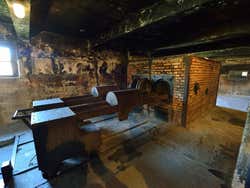
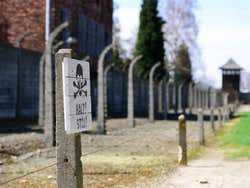

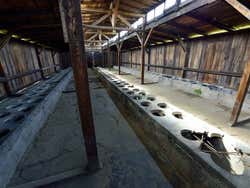
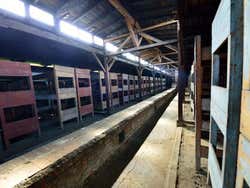
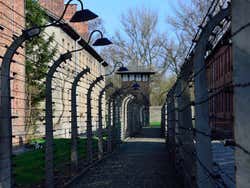
Schedule
Every day from 7:30 a.m. to 2:00 p.m. and 7:00 p.m. (depending on the season).
Price
Adult tour: zł 110 (US$ 29.13).
Students under 26, seniors over 75, and people with disabilities: zł 100 (US$ 26.48).
Transport
Bus from the central station
Nearby places
Kraków Airport (42.1 km)
